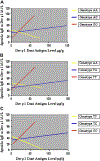Dust mite exposure modifies the effect of functional IL10 polymorphisms on allergy and asthma exacerbations
- PMID: 18440625
- PMCID: PMC6124308
- DOI: 10.1016/j.jaci.2008.03.015
Dust mite exposure modifies the effect of functional IL10 polymorphisms on allergy and asthma exacerbations
Abstract
Background: The allergenicity of dust mite exposure might be dependent on variants in the gene for IL-10 (IL10).
Objectives: To evaluate whether dust mite exposure modifies the effect of single nucleotide polymorphisms (SNPs) in IL10 on allergy and asthma exacerbations.
Methods: We genotyped 6 SNPs in IL10 in 417 Costa Rican children and 503 white children in the Childhood Asthma Management Program (CAMP) with asthma and their parents. We used family-based and population-based approaches to test for interactions between IL10 SNPs and dust mite allergen on serum IgE to dust mite in Costa Rica and on asthma exacerbations in Costa Rica and CAMP.
Results: Dust mite exposure significantly modified the relation between 3 SNPs in IL10 (rs1800896, rs3024492, and rs3024496) and IgE to dust mite in Costa Rica (P for interaction, .0004 for SNP rs1800896). For each of these SNPs, homozygosity for the minor allele was associated with increased levels of IgE to dust mite with increased dust mite exposure. Homozygosity for the minor allele of each of the 3 SNPs was associated with increased risk of occurrence (approximately 3-fold to 39-fold increase) and frequency of asthma exacerbations among children exposed to > or = 10 microg/g dust mite allergen in Costa Rica. Similar results were obtained for 2 of these SNPs (rs1800896 and rs3024496) among white children in CAMP.
Conclusion: Our findings suggest that dust mite allergen levels modify the effect of IL10 SNPs on allergy and asthma exacerbations and may partly explain conflicting findings in this field.
Conflict of interest statement
Disclosure of potential conflict of interest: D. R. Gold has given talks on indoor allergens for Indoor Biotechnologies Ltd. S. T. Weiss has consulting arrangements with Schering-Plough, Genentech, Variagenics, Genome Therapeutics, and Roche Pharmaceuticals and has received research support from AstraZeneca, Millennium Pharmaceuticals, Pfizer, Boehringer Ingelheim, and Glaxo Wellcome. The rest of the authors have declared that they have no conflict of interest.
Figures


Comment in
-
Genes and the environment: two readings of their interaction.J Allergy Clin Immunol. 2008 Jul;122(1):99-100. doi: 10.1016/j.jaci.2008.05.017. Epub 2008 Jun 10. J Allergy Clin Immunol. 2008. PMID: 18547630 No abstract available.
References
-
- Akbari O, DeKruyff RH, Umetsu DT. Pulmonary dendritic cells producing IL-10 mediate tolerance induced by respiratory exposure to antigen. Nat Immunol 2001;2:725–31. - PubMed
-
- Lim S, Caramori G, Tomita K, Jazrawi E, Oates T, Chung KF, et al. Differential expression ofIL-10receptor by epithelial cells and alveolar macrophages. Allergy 2004;59:505–14. - PubMed
-
- Oh JW, Seroogy CM, Meyer EH, Akbari O, Berry G, Fathman CG, et al. CD4 T-helper cells engineered to produce IL-10 prevent allergen-induced airway hyperreactivity and inflammation. J Allergy Clin Immunol 2002;110:460–8. - PubMed
Publication types
MeSH terms
Substances
Grants and funding
- P01 HL083069/HL/NHLBI NIH HHS/United States
- P01HL083069/HL/NHLBI NIH HHS/United States
- U01 HL065899/HL/NHLBI NIH HHS/United States
- U01HL65899/HL/NHLBI NIH HHS/United States
- R37 HL066289/HL/NHLBI NIH HHS/United States
- T32HL07427/HL/NHLBI NIH HHS/United States
- R01HL086601/HL/NHLBI NIH HHS/United States
- N01 HR016049/HL/NHLBI NIH HHS/United States
- R01 HL066289/HL/NHLBI NIH HHS/United States
- WT_/Wellcome Trust/United Kingdom
- R01 HL086601/HL/NHLBI NIH HHS/United States
- F32 HL083634/HL/NHLBI NIH HHS/United States
- T32 HL007427/HL/NHLBI NIH HHS/United States
- K01 HL004370/HL/NHLBI NIH HHS/United States
- N01-HR-16049/HR/NHLBI NIH HHS/United States
- U01 HL075419/HL/NHLBI NIH HHS/United States
- U01HL075419/HL/NHLBI NIH HHS/United States
- HL04370/HL/NHLBI NIH HHS/United States
- K08 HL074193/HL/NHLBI NIH HHS/United States
- HL66289/HL/NHLBI NIH HHS/United States
- 1F32HL083634/HL/NHLBI NIH HHS/United States
- HL074193/HL/NHLBI NIH HHS/United States
LinkOut - more resources
Full Text Sources
Medical
Molecular Biology Databases

